Over the past few months, I have been wearing an MLV-C airbag vest from Hit-Air. During this time I have written about adding an airbag vest to my everyday riding gear and how I came to decide on the Hit-Air MLV-C for me. Now that I’ve had some time to wear the vest on a regular basis it’s time to follow up with my thoughts and final review.
When I started riding with this vest it was late winter and the temperatures during the day barely broke 50 degrees (F). Now with Summer approaching and the temperatures already up in the 90’s (F) during the day here in Nashville, TN, I’ve had a chance to evaluate what it is like to live with the MLV-C vest over different riding jackets and ambient temps.
That leads me to the first point…
Shopping Now? We Recommend:
webBikeWorld has worked closely with Amazon over the years to provide our testers with products to review. In addition to being a great site to shop from, they’re also a great partner.
Amazon
Free shipping (with Amazon Prime)
30-day return policy
Excellent selection
Competitive pricing
The Heat Question
The most frequently asked question that I have gotten about the vest is “Is it hot to ride in?”.
The answer is “It depends”.
When the temperatures rise many riders, including me, reach for textile mesh and/or perforated leather gear. Seeing as the airbag vest is going to sit on top of whatever jacket one is wearing, it’s going to restrict airflow to some degree. How much will depend on where and how much mesh is part of the jacket being covered.
Hit-Air-MLV-C-Vest chassis
Taking a look at the MLV-C vest you see that Hit-Air has done a good job of keeping the design “open”. There are two large gaps in the back for air to flow through and the entire center of the front is open save for the two snap buckles holding the vest closed. While the vest overall will still restrict airflow it should do as well if not better than many other airbag vest designs I’ve seen.
For my own use, I found that when paired with my Pilot Motosports Elipsol jacket, the location of the mesh on the front of the jacket was completely covered by the vest. This rendered these mesh panels effectively useless. This is a shame as I really like the Elipsol jacket and it does a decent job flowing air when it’s hot.
Since I want to wear the vest as often as possible, a new mesh jacket was in order. The Knox Zephyr Jacket (review coming soon) ended up being my choice to replace the Elipsol. The Zephyr has a full mesh panel front and back as well as on the inside facing sides of the sleeves. The included Microlock back armor is very perforated so air can flow and it isn’t as restricted compared with other in-apparel back armor.
The combination of Zephyr jacket and MLV-C vest proved to be much better in the ninety plus degree heat we’ve had lately. There’s still no getting around the fact a vest is going to block some air, but with the right jacket, it’s manageable and I feel the added safety benefit is worth the reduction of airflow.
With the big question out of the way, let’s dig into the details.
Construction
The chassis of the vest is made from nylon with polyester mesh located behind the neck and on top of the collar. Two plastic buckles up front are used fasten the vest with the lower one connected to adjustable straps for size adjustment.
Scattered around the vest are snaps. These snaps hold closed the covering under which the polyurethane airbag is placed. These snaps pop open when the bag inflates allowing it to expand. Having the bags “packed” under the snaps keeps the material from flapping about in the wind when riding.
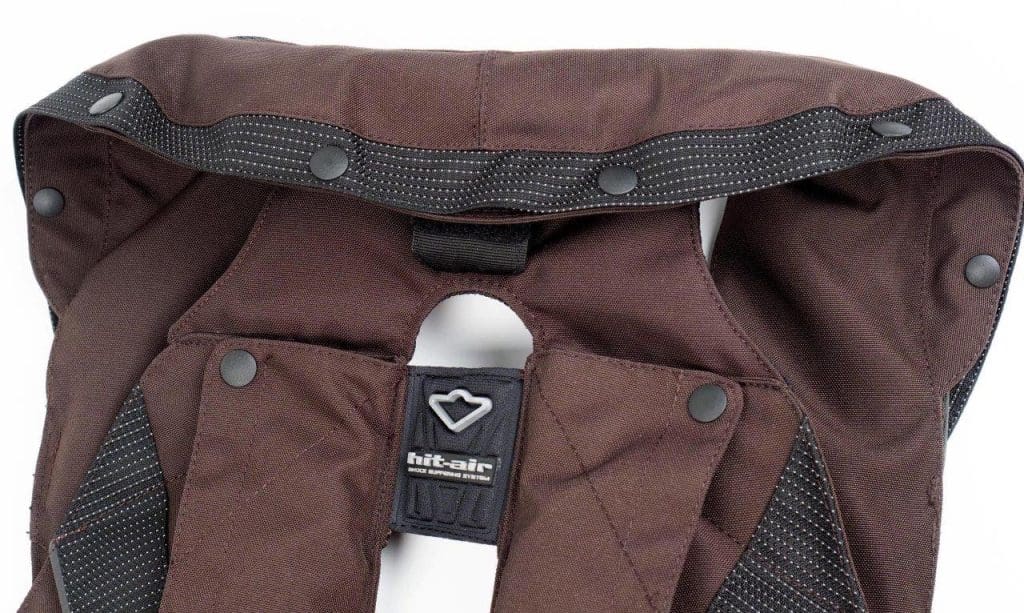 Something I wanted to point out is that in several places in those folded spaces and on the inside of space on the vest are small zippered openings. These appear to be used to install or replace the airbag. These zippered openings are labeled “Do Not Open” quite clearly but of course, that makes me want to open them even more, but I haven’t.
Something I wanted to point out is that in several places in those folded spaces and on the inside of space on the vest are small zippered openings. These appear to be used to install or replace the airbag. These zippered openings are labeled “Do Not Open” quite clearly but of course, that makes me want to open them even more, but I haven’t.
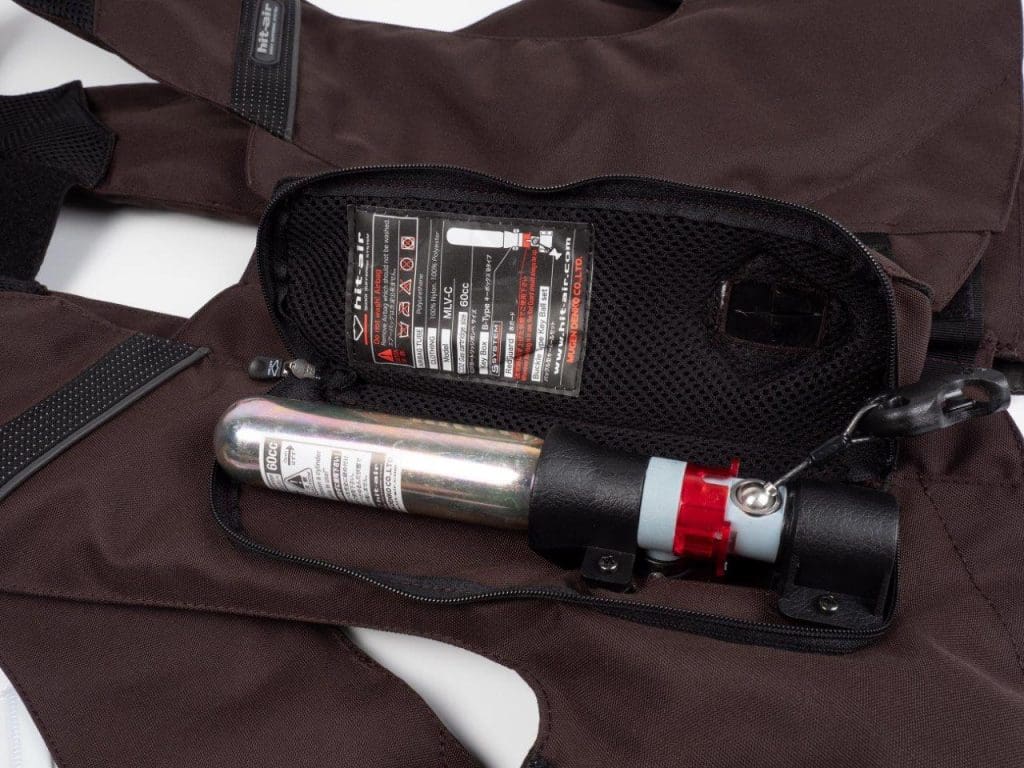 Located on the right front side is the zippered pocket containing the CO2 cartridge and mechanism for inflating the vest. This access point is used to replace the gas cylinder after use or the entire mechanism, or “keybox”, can be replaced if it is damaged in a crash. The keybox sits on top of the bag so the hard parts are kept away from the rider’s body in an impact.
Located on the right front side is the zippered pocket containing the CO2 cartridge and mechanism for inflating the vest. This access point is used to replace the gas cylinder after use or the entire mechanism, or “keybox”, can be replaced if it is damaged in a crash. The keybox sits on top of the bag so the hard parts are kept away from the rider’s body in an impact.
Since the vest could potentially cover reflective material on one’s jacket Hit-Air has conveniently place reflective material on the vest. There are strips on the chest, around the collar, and on the sides and it’s made up of small dots of reflective material. In other apparel, I’ve seen similar looking reflectors but they don’t often do much. These, however, are very bright and show very brightly when hit with a direct light like a headlight.
Shopping Now? We Recommend:
webBikeWorld has worked closely with Amazon over the years to provide our testers with products to review. In addition to being a great site to shop from, they’re also a great partner.
Amazon
Free shipping (with Amazon Prime)
30-day return policy
Excellent selection
Competitive pricing
Fit & Comfort
The MLV-C vest is available in two sizes with the smaller covering sizes small to XL and the larger one for XL up to 3XL sizes. This sizing is based on one’s jacket size and designed to fit over jackets of the listed sizes. The smaller one works fine over my size medium jackets and judging by the available adjustments I expect it would fit as Hit-Air describes.
The chest fastener doesn’t have any adjustment but I would say it should cover up to a 46 to 48-inch chest. The lower buckle is attached to hook and loop straps that offer several inches of adjustment. If one needs a little extra room Hit-Air sells extensions that will expand the buckle closures if needed.
This size MLV-C tips the scales at 2 lb 8.5oz (1148g) and most of that weight comes from the keybox and gas cylinder. Two and a half pounds really isn’t that much but it is noticeable at first, especially with most of the weight on the right side of the front. Once underway a few minutes the vest really disappears into the background like most riding gear does.
Additional Protection
The MLV-C has provisions for adding additional impact protection in the form of back, chest, and side protectors. Hook and loop fastener is in place at the chest and the back for attaching Hit-Air’s protectors and the side impact pieces attach to the adjustment strap for the main lower buckle.
I considered installing an additional back protector but I already have CE level 2 protectors in the back of my jackets. Adding more might not make an appreciable difference. It is important to note that the vest is NOT is a replacement for a back protector and if one doesn’t have one in or under their jacket they should get one or install one of the Hit-Air protectors.
Installation
The tether for the MLV-C vest is designed to be installed below and to the front of the rider. This can be a sturdy point on the frame of the bike or even an appropriate location under the seat. It is important to note that the design of the MLV-C and most of the Hit-Air models are designed to have that tether in front of the rider. The exception is a race model which places the keybox on the rear of the vest and the tether, in this case, is installed behind the rider.
Under the seat of my Ninja 1000 is the fuel tank support strut which is an ideal place for anchoring the tether. This location allows me to keep the anchor point hidden and without the bike key to remove the seat, the tether can’t be removed short of cutting it off above the seat rendering it pretty useless.
The tether is longer than most bikes will require and it is designed to be trimmed to fit once it has been adjusted to the correct length. The instructions are easy to follow and require just a few minutes to find the right length. This involves putting on the vest and connecting it to the anchored tether and then standing on the pegs of your bike.
Doing this will allow one to determine the minimum length needed to allow maximum freedom of movement. The tether includes a clamp for creating a loop making it easy to adjust the size of the loop and length to the vest clip. Once the correct length has been set I would recommend leaving the length of the tether in place until after you’ve had a chance to ride some, just to make sure.
The tether comes with a length of soft tubing that covers the cable at the anchor point to prevent the tether from rubbing on any paint. It also protects the tether from any edges that may be present on the part of the frame where attached. Overall, the installation may take 15 to 20 minutes at most. I spent about twice that but I was also stopping to take photos for the review.
Hit-Air also sells additional tether cables for riders that want to use their airbag vest (or jacket) on multiple bikes. They even sell an accessory that clips into the buckle to keep the tether from dangling when not wearing the airbag vest or jacket.
Conclusion
I like it.
That’s a pretty simple answer for someone who is as “wordy” like me but it’s a fair summary. There really is little to dislike. Installation is simple and easy and fit was as expected and can be easily expanded using the accessory extenders.
The MLV-C vest will block some airflow of mesh/vented riding jackets. The amount will vary depending on the jacket design but it seems like a fair trade-off for the extra protection. The price might seem a bit high but I don’t see it that way. The MLV-C starts at $479.00 which is about the same price as a good helmet.
Of course, an airbag vest is no panacea and will not make a rider invincible. It’s just one of many pieces of the protection puzzle each rider assembles according to their own idea of risk mitigation. An airbag vest may not be for everyone but it’s found a permanent spot as a part of my riding gear.
Specifications
- Product: MLV-C Airbag Vest
- Manufacturer: Hit-Air
- Sizes: Medium (covers S – XL), Large (covers XL-3XL)
- Color(s): Black, White, Red, Blue, Brown, plus special edition colors
- Made In: Japan
- Price: $479.00 base ($509.00 as tested)
Shopping Now? We Recommend:
webBikeWorld has worked closely with Amazon over the years to provide our testers with products to review. In addition to being a great site to shop from, they’re also a great partner.
Amazon
Free shipping (with Amazon Prime)
30-day return policy
Excellent selection
Competitive pricing
Hit-Air MLV-C Image Gallery
*Article originally published at Motorcycle Words by Brandon Jackson.

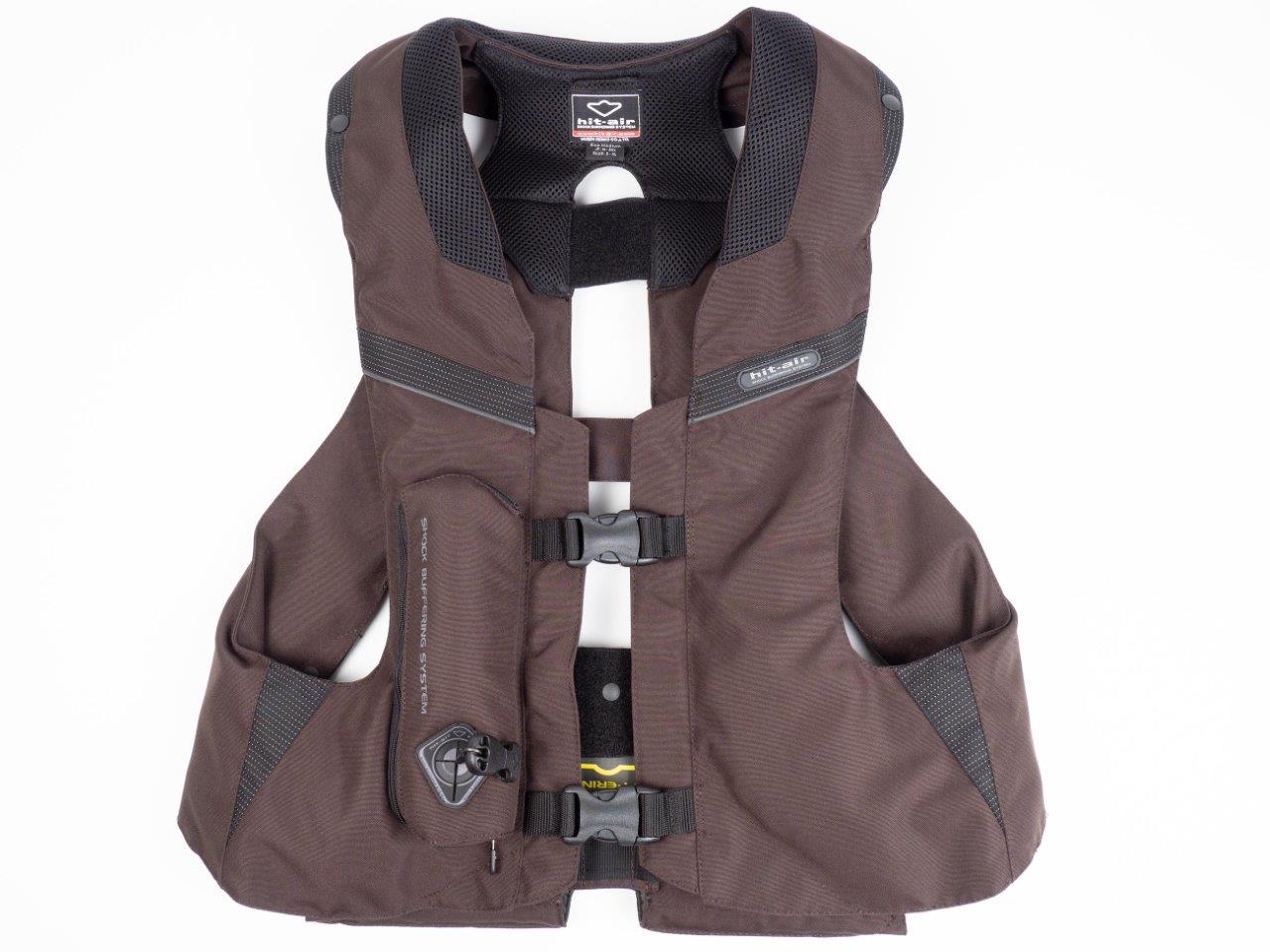
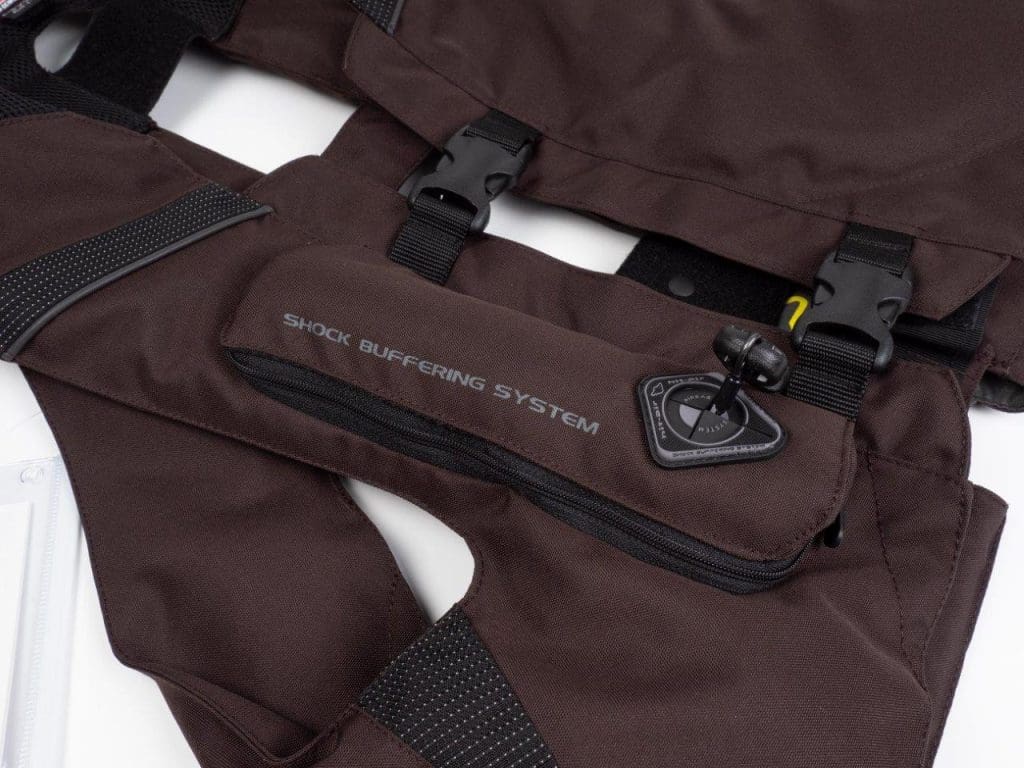

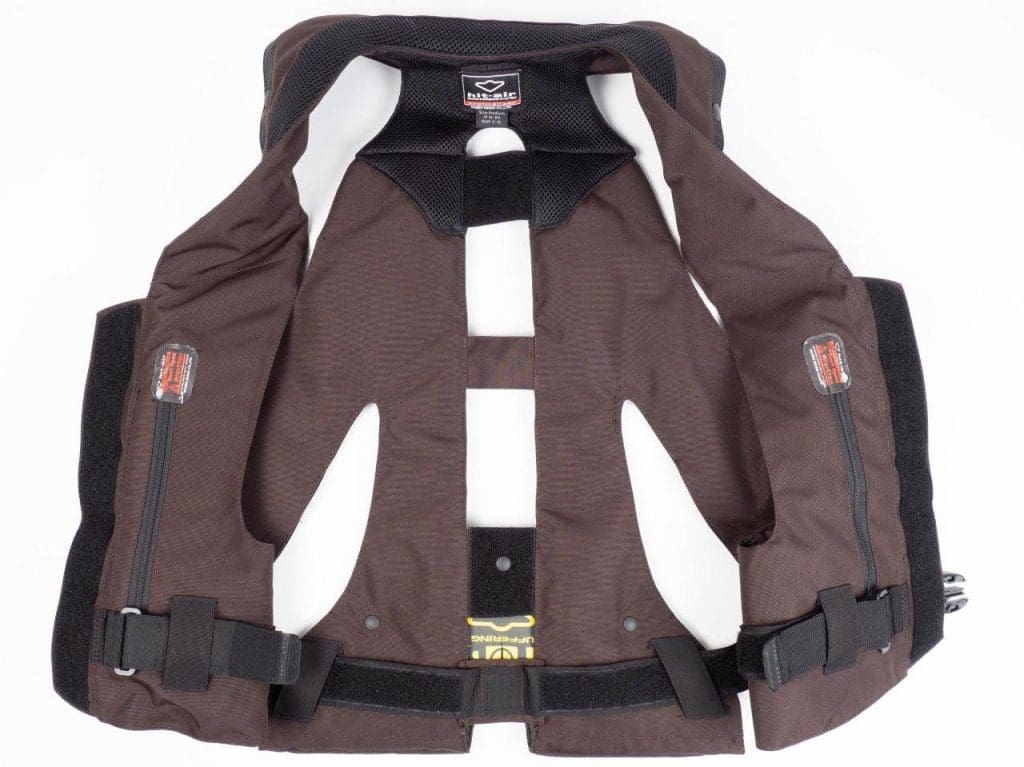
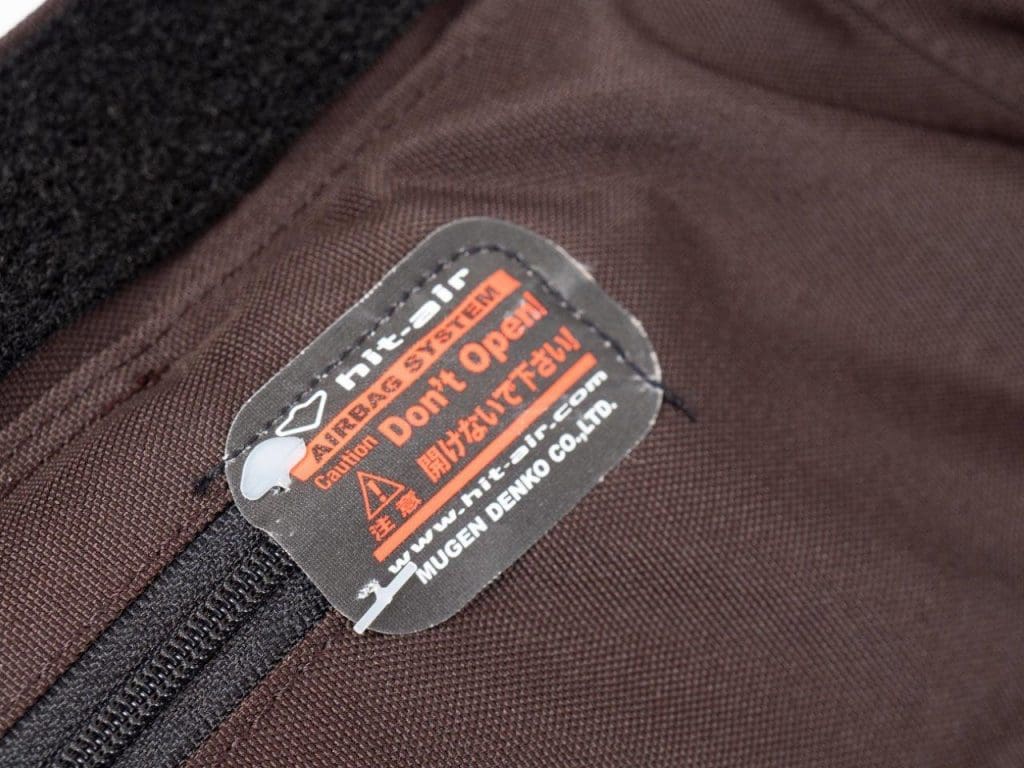
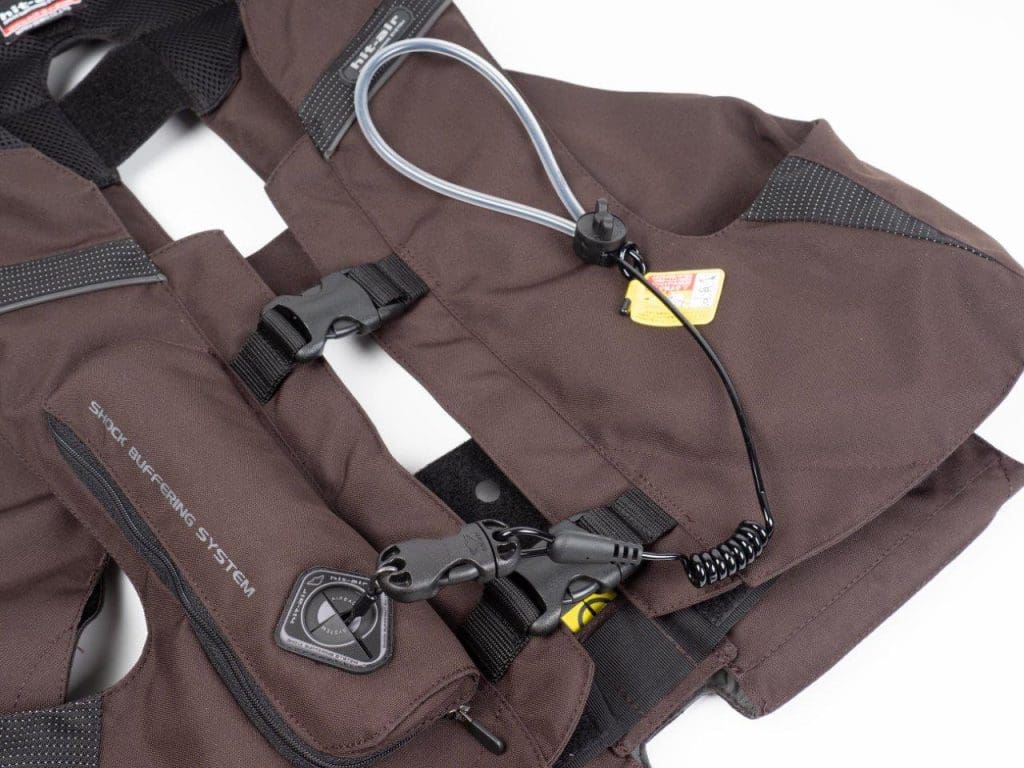
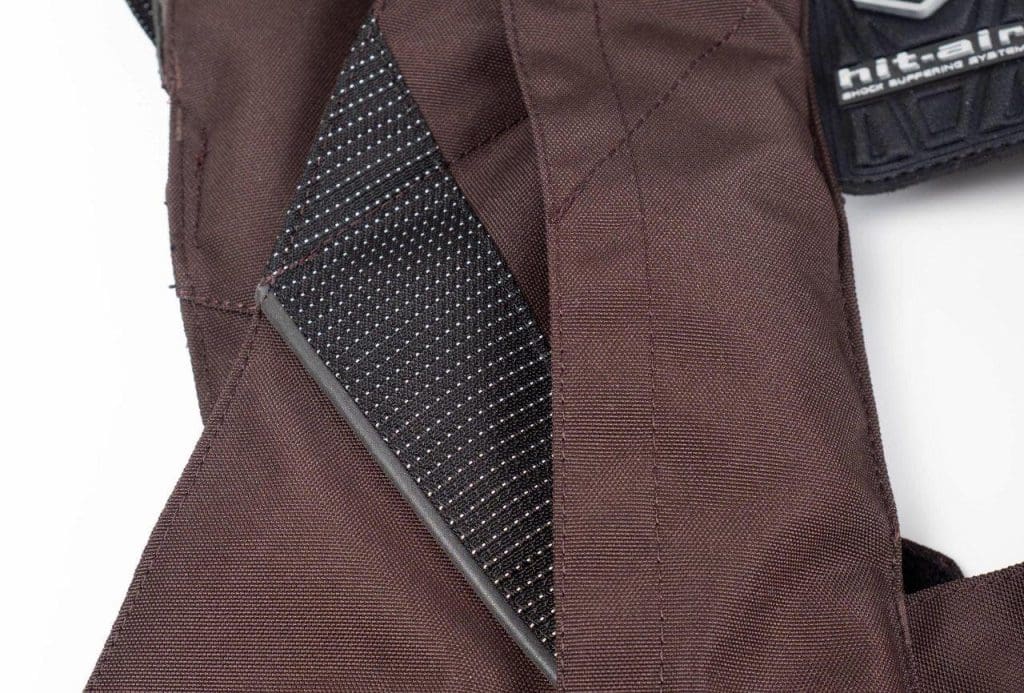
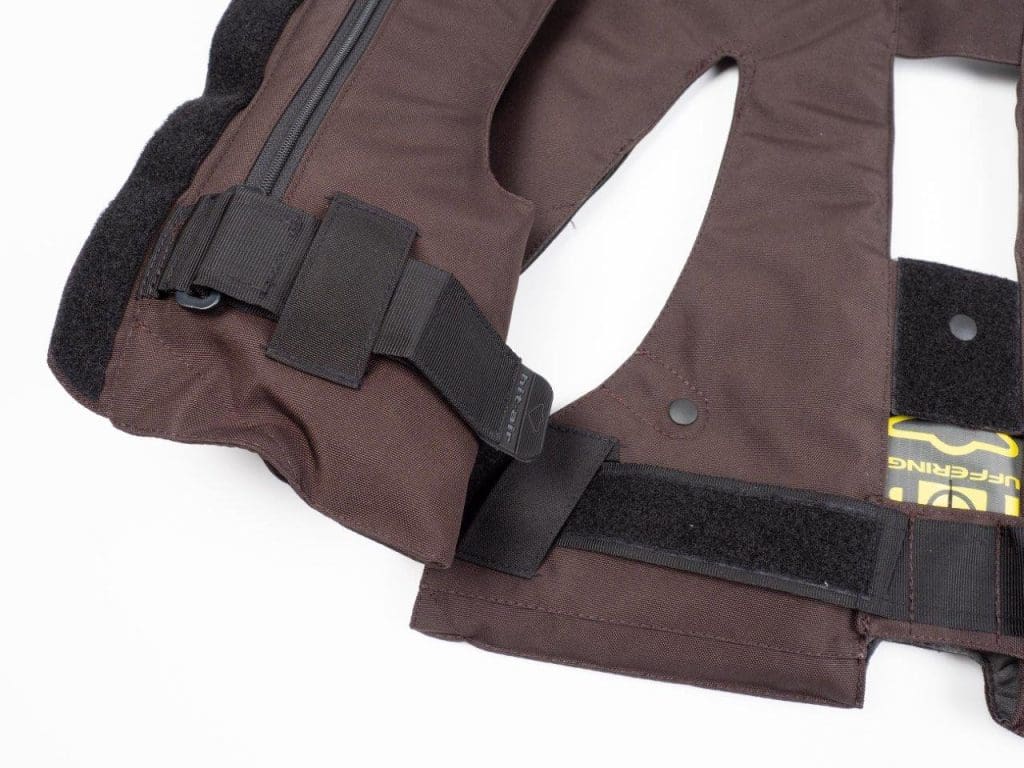
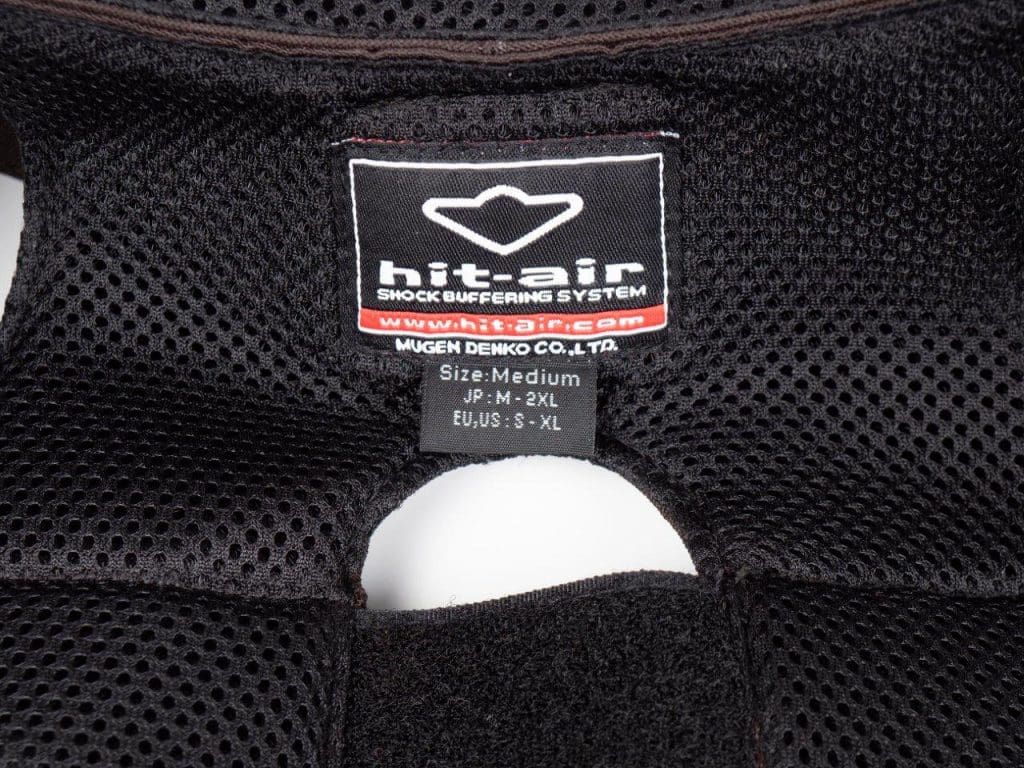
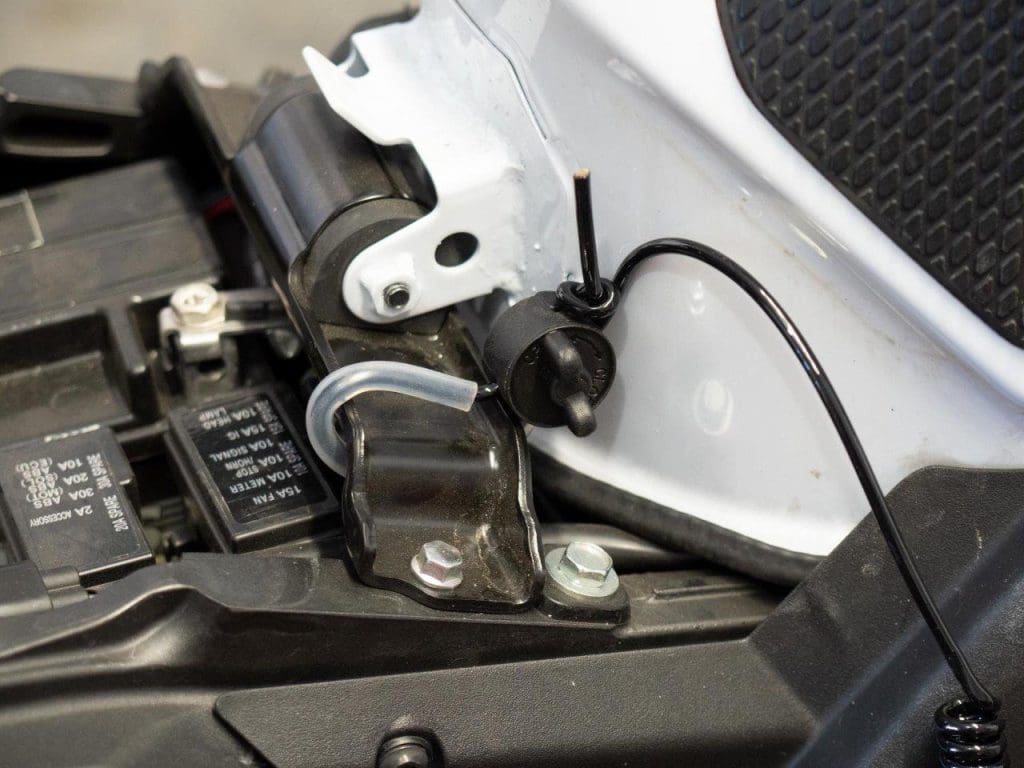
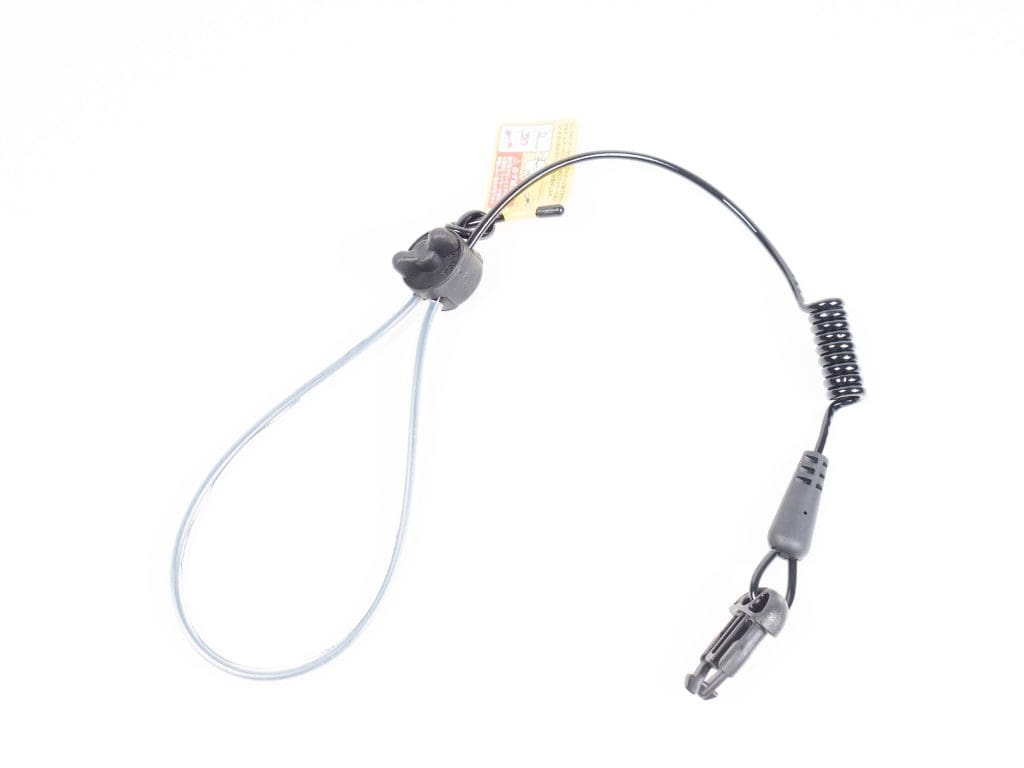
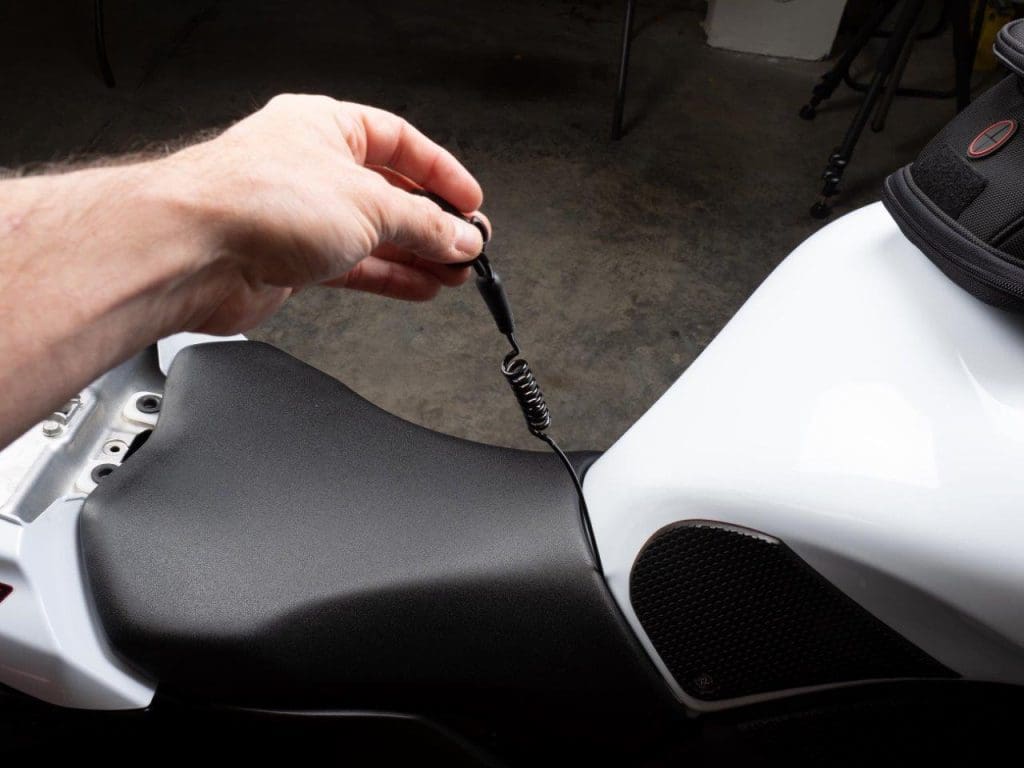

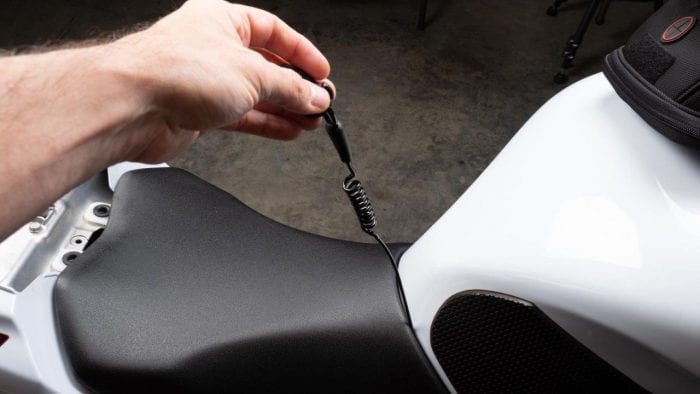

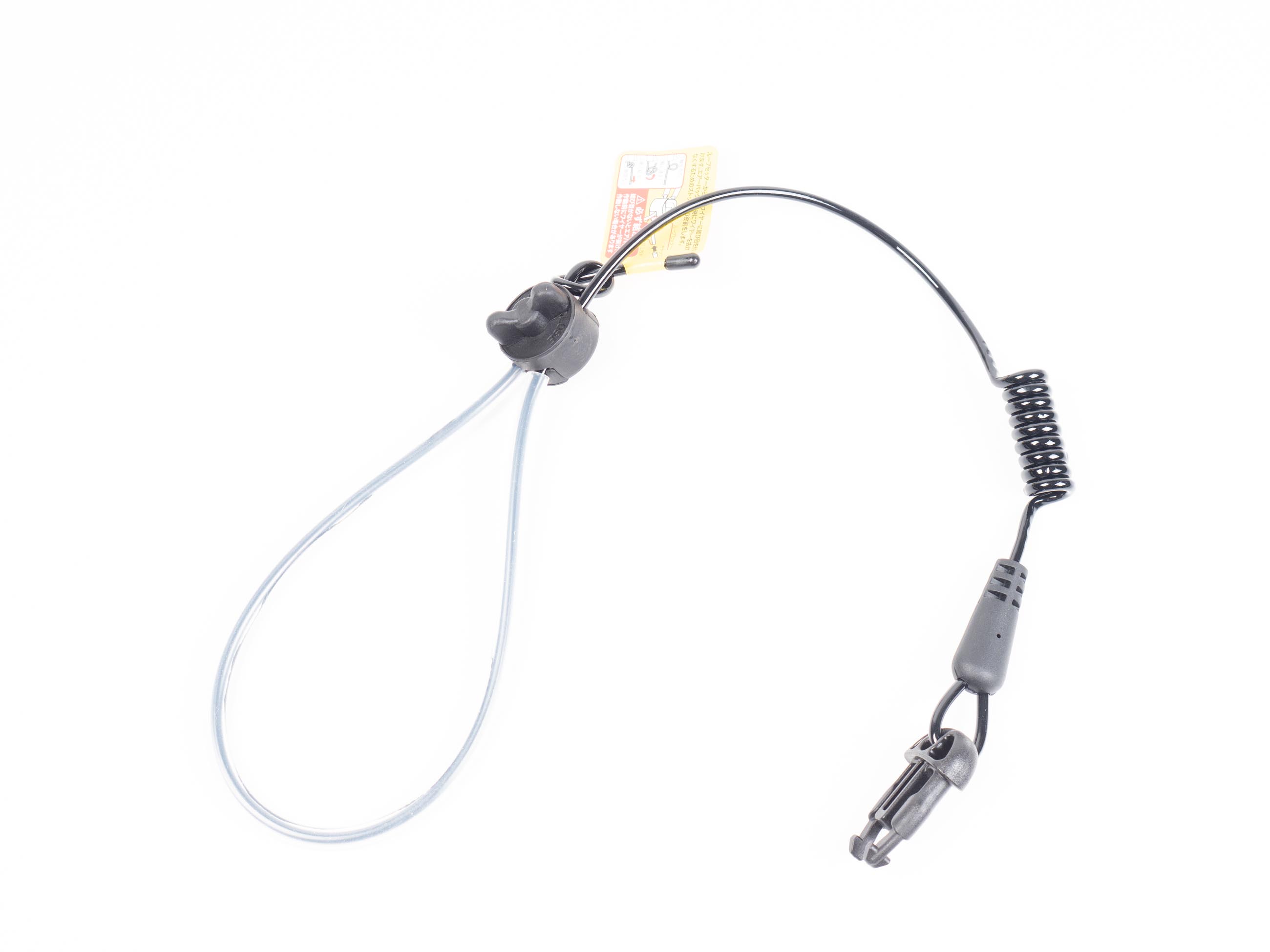
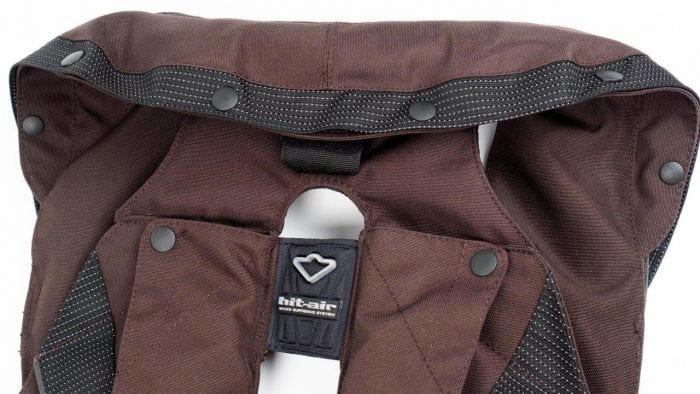
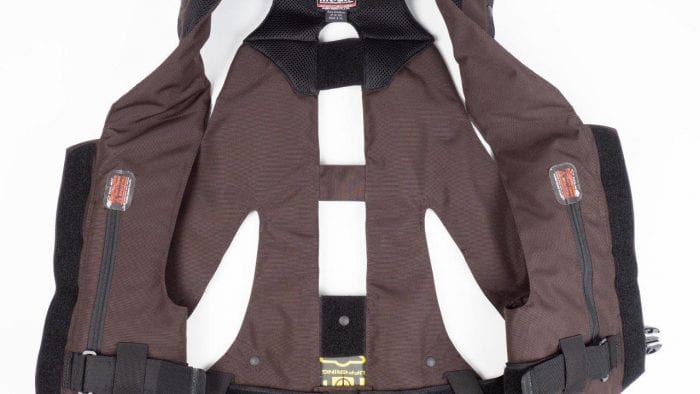
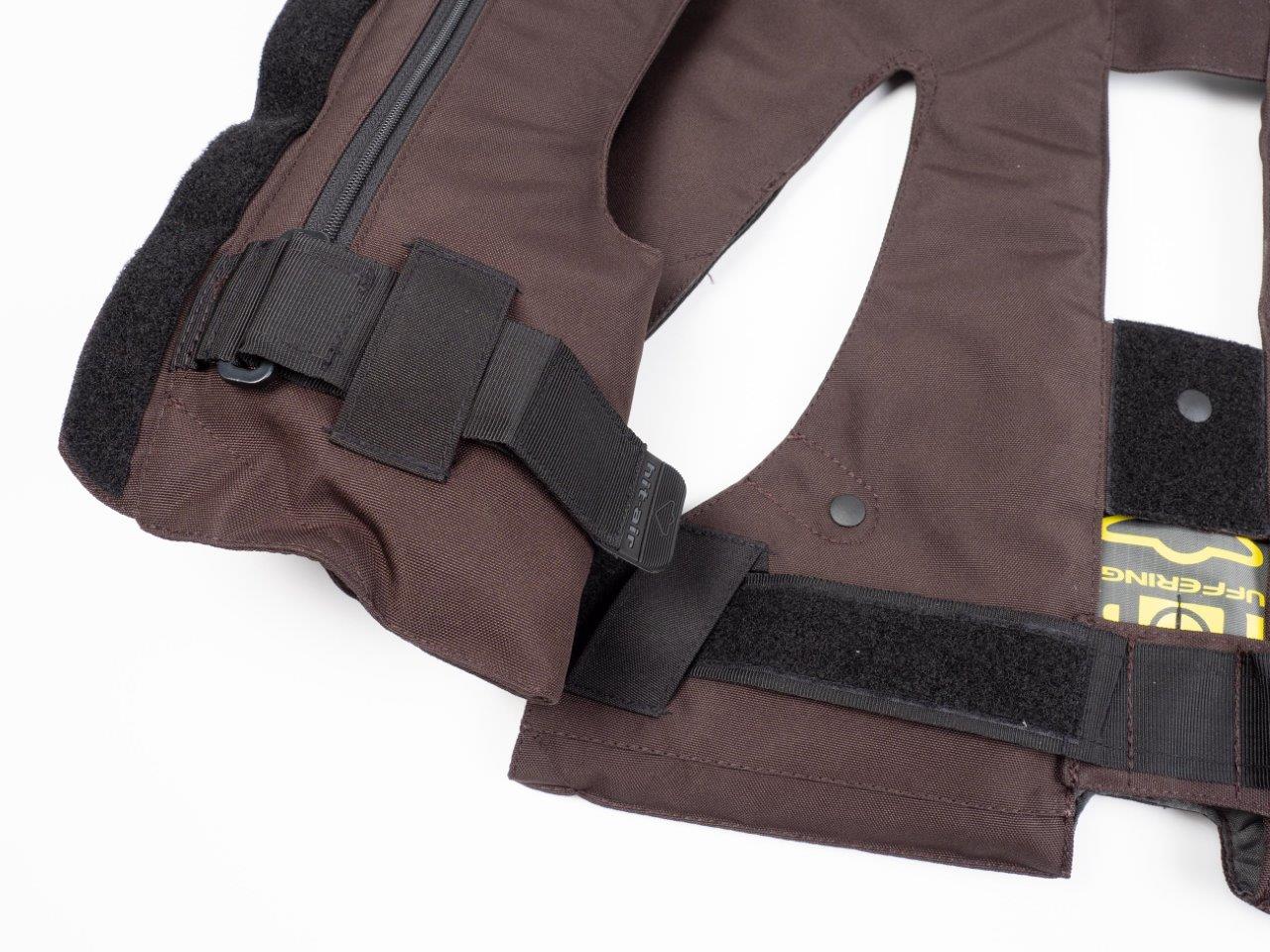
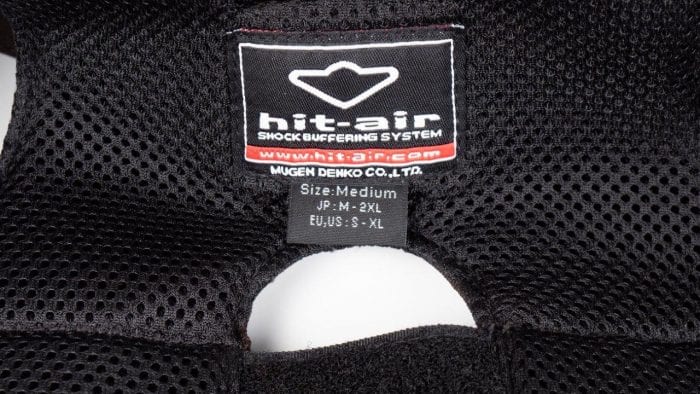
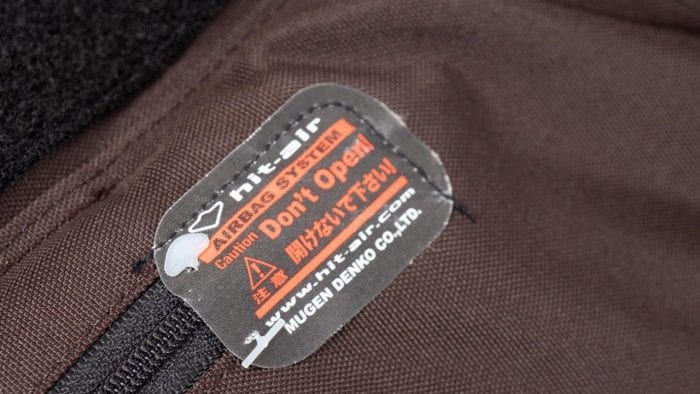
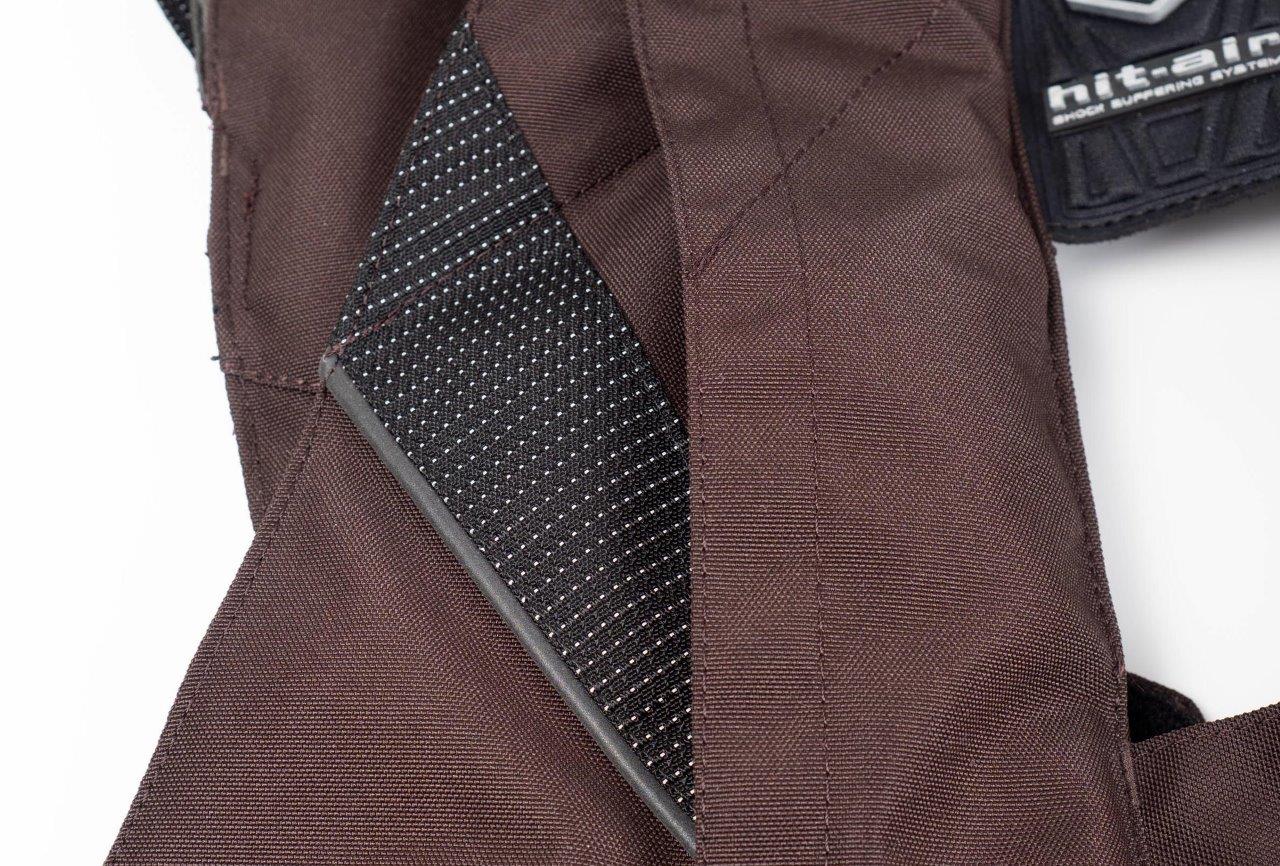



You’ll note that no automobile airbag uses CO2 inflators. That’s because they’re too slow – impact happens before the bag is fully inflated. They use explosive gas generators.
Similarly, motorcycle airbags that use CO2 inflators are most likely useless. The good ones (Dainese) use explosive inflators just like cars.
It is too bad that reviewers give credibility to these quack products.
I beg to differ. Have you done any research on this? I spent months looking at the products and chatting with users who have crashed in their airbag vests before I decided to get one and add it to my everyday gear.
Are these types of vests a panacea,? No, but neither are the electronic vests from Dainese and Alpinestars. Yes, those vests do have more powerful inflation systems and advanced electronic triggering mechanisms. They are also much more expensive and require sending back to the manufacturer for service after being deployed. They are one shot only.
I’m not saying these higher tech airbag systems aren’t good, but I don’t think they are in reach of many riders at this time. In addition they require specially designed gear for use with them.
Back to the tethered systems though, I ‘ve gathered quite a bit of information in the form of photos and testimonials from real world users on how effective their vests were when they had serious crashes including being struck from behind on a California interstate (the bike was destroyed, the rider left with a broken leg but no upper body injuries) and another case striking a deer at speed and taking a tumble (where the rider was up on his feet soon after).
The above are just two examples, but there are a lot more out there (just search it). I hope I never get to find out how well these vests work first hand but I feel just a little safer riding in one which in the end, help me enjoy my ride that much more.
I welcome everyone’s opinion but I think it is too bad when comments call things “quack products” without any basis for calling them so.
I also beg to differ on this. I have been in an accident while wearing the helite vest. I was stopped on the emergency lane and a car hit my bike 50 miles an hour. I woke up on the floor.
I had no pain on my neck. The vest inflated so fast that I did not even get a whiplash injury. The vest was fully inflated before my neck had time to go back to cause any pain at all.
I am talking about a crash that threw me in the air and I fell down 30 feet from my bike.
Some examples…
https://www.twincities.com/2016/08/29/his-motorcycles-totaled-but-hes-fine-thanks-to-high-tech-gear/
https://www.youtube.com/watch?v=ZaykzE7P_XE
https://advrider.com/f/threads/a-year-ago-today-celebrating-being-alive.1290456/#post-34636439
This is a good review on a piece of riding gear that more and more riders are using.
I’ve owned the hi-vis version of this for about three years now, maybe four. I won’t ride without it. Deployment times have worked well for me. Twice now, I’ve deployed it, the first being the most serious.
I was turning right into heavy traffic when a pedestrian (who had the right-of-way) stepped out in front of me. The only option was to hit the front brake, which caused a high-side. I remember only seeing the kid, hitting the brake…and laying on my back against the curb. After a moment, I realized I didn’t hurt, yet my ribs and back were against the edge of the curb. Then I remembered the air bag vest, and sure enough, it was deployed. I have no doubt I would’ve had broken ribs from that fall and how I landed. Instead the only damage was to my pride.
For anyone wondering if it will deploy if you walk away without unhooking the tether, it won’t. It takes more force than that…like an actual fall off your bike.
I’ve worn mine on some multi-state tours in temperatures around 105F. I’ve read that at somewhere around 93-94F, your body can’t provide enough perspiration to cool your skin down. From that point on, you actually want to limit the amount of air flowing to your body. I wore a long-sleeved base layer with a cooling vest, then a Olympia Dakar mesh jacket over that, and of course my Hit-Air MLV-P vest. My cooling vest lasted 3 hours in that heat. A couple I met at a rest stop, said their cooling vests only lasted half an hour…but then they had mesh jackets and nothing to limit the air flow.
So the vest can be used for all day riding in high temperatures.
One big advantage to buying any air bag vest is simply that you can move it from one riding jacket to another. Many of us that ride year around have three season jackets that cover the Fall/Winter/Spring or Spring/Summer/Fall temperatures. With a separate vest, I can wear it with either jacket. With the air bag built into the jacket, I can’t.
Have you researched these at all, Randy, or are you just spewing bull?
While it may be true that some early models took .5 seconds or more to completely inflate, the technology has continued to improve… as technology does. Even the less expensive models inflate fully in much less than half a second. That’s enough time to help protect your innards from the concrete or a tree.
For you to jump on here and poopoo a safety device is, at the very least, irresponsible and, at worst, fatal should someone decide to heed your uneducated “advice”.
And should your next comment be the ubiquitous, “It will make riders overly confident”, I’ll head you off. I don’t currently wear an air vest but I’m starting to look into it. I wear a full face helmet, armored jacket and pants, and motorcycle specific riding boots. But there is nothing that can make me feel overly confident when I’m cruising at 70 mph with 4000 lb hunks of metal surrounding me, driven by people that may occasionally be troubled to look up from their cell phones while driving.
There is no perfect protection for a motorcyclist. But this can give us just that little bit more of a chance of living through a crash. Do you really want to try to talk ANYONE out of a little extra survival insurance?
If nothing else, maybe an air vest will protect us from all this BS you’re spewing all over.
Randy I know personally people that have used co2 air vests and they inflated in more than enough time. You are just parroting some BS you read off a forum somewhere.
If you actually knew anything about physics you would not that helium is the fastest gas to to transfer through small openings.
Troll elsewhere
I purchased an early model of the Hit-Air vest back in 2009 with the original slower inflation system. It arrived on a Saturday morning about 30 minutes before I was going on a five hour ride. I installed the tether behind my seat (after reading this article I will be changing it immediately to the front) and rode off. Less than 15 minutes from home I was following too close to a minivan on the interstate when I dumped the bike in an emergency stop. The air vest deployed immediately as I “bounced” off the pavement going 50 MPH. Luckily no one rode over me and I later found out I had cracked a rib, and of course had to replace my helmet, but I truly believe I would have been permanently injured without the vest. I have been riding over 40 years and have only layed down a couple of times but I won’t go anywhere without my Hit-Air vest. I find it amazing that I have never talked to any motorcyclist who have even heard of a air vest, let alone wear one. Perhaps it’s the older crowd I ride with (I’m 68 and ride with fellow Veterans, but I talk it up everywhere I go. Now that I see their newer design I will be ordering one. My only complaint is the Japanese sizing. I’m 6’1” and have a 46” chest and the 3XL just fits over my leather jacket.
Ride safe, Don.
Hi,
Has anyone used a back pack with one of these vests, or jackets? I am thinking of a hydration type of back pack. The manufacturers don’t really mention back packs.
Also, what about rain coat over a vest or jacket?
I suppose it all depends on how tight the pack or rain coat is?
Thanks for any feed back.
Cheers,
DaveW
Like Brandon, I haven’t used a hydration backpack with mine. You might be able to make it work. I would look for an alternative solution to drinking on the move, like putting the hydration bladder into my tank bag.
Another thought is that if you’re using a hydration backpack, are you riding in warm weather? I’m assuming you are. The airbag will cut down on some of the air flowing through a mesh jacket. Putting a backpack over that would cut down on some of the air flowing through also.
As for raingear, it has been years since I’ve worn any and I ride year around in Seattle. My Olympia jackets have either a built-in rain liner (the Ranger) or a windbreaker type rain liner (the Dakar). The windbreaker type rain liner goes under the airbag.
I wrestled with a similar set of questions in my mind when I was planning my post-retirement ride from Seattle to the 5 national parks in Utah. I knew temps would be far hotter than I was used to riding in in Seattle. At some points, the temps would be hot enough that I would cross that threshold where the thyroid gland can’t keep up with the sweat production and it is actually wiser to start limiting air flow, rather than having full flowing mesh. Which jacket would work best?
The bottom line for me was that I was not going without the airbag vest. I’d been wearing it for a couple years by then and I won’t ride without it now. So whatever solution I found for my clothing conundrum, would include the airbag. I hope you can do the same.
Hi,
Thanks so much for the reply and the feedback, I really do appreciate it.
I most likely will find an alternate to the hydration pack. I can’t imagine it working with the vest (not to mention the pain of having to put on, basically, two packs). It might work with the jacket, if worn loosely.
One last question, do you have an idea on the diameter of the tubes when inflated? Hard to tell from the photos online.
Cheers,
DaveW
I haven’t personally tested it but with the MLV-C vest I have, I don’t think putting anything over it that cannot stretch significantly would be a good idea. As for rain gear, it depends as some things, like frogg toggs , might be loose enough to work. In my case I have a Rev’It rain jacket that fits pretty close to to non-waterproof jackets. I would end up using it under the vest. I don’t think the vest itself has any issue getting wet.
Thanks also to you, Brandon, for responding to my inquire.
As you say, unless the rain shell was loose enough, I wouldn’t put it on the outside of the vest or the hit-air jacket. Thus, my question to you and Chris about the diameter of the tubes when inflated. But, it is not important enough for you all to do anything if the answer is not right off the top of your head. I can always wear the shell under the vest. Just sometimes it is easier to put the shell over everything if it starts to rain suddenly.
Cheers,
DaveW
Hah!…send me about $25 to my PayPal account and I’ll be glad to blow it up for you. 😀
The $25 would be for a new CO2 cartridge. …
Ok, I know you are just dying to pop that puppy to see it blown up.
Naw, the diameter was more of a curiosity. I am sure that it be best to put the rain shell and everything else under the vest or jacket. I suspect that even if the body of the rain shell had enough bulk to it, the collar being closed would be a problem when the neck roll popped.
Again, thank for the help and opinions.
Cheers,
DaveW
This kind of air-bag vest should become mandatory for every riders in the future. Many still ignore the safety which is very dangerous and fatal mistake.
I don’t know about “mandatory” but I’m all for encouragement of the use of safety devices like this. While I wear mine all the time when riding on the street not everyone feels it is necessary. We all have to manage our own level of risk and plus these vests are not inexpensive.
Nice review Brandon. Any chance to test a jacket that incorporates the airbag? Hit Air makes them, also Helite (not considering the electronics ones, I do not want another battery to check). It would be nice your thought on comfort and usabilty (I do not really like the idea of an extra layer of garment, it takes me already a lot of time to dress up for riding and the bulk of having to store everything when I leave the bike…). Keep it up!
Sorry I missed this comment (my notifications weren’t working on this back a this time). And no, I haven’t had a chance to test the full on jackets but would be interested in checking them out.
FWIW, when I take my jacket off, I take my Hit-Air vest off at the same time. And put them on at the same time.
Hey guys, as always top quality write ups. Due to this article decided to pull the trigger on the airbag vest. Went with the MLV-RC. 1st thing that I missed is I no longer will be able to wear a backpack (Kriega R20 goes on holidays, but my new bike has twice as big topbox as the old one, so not a biggie). Also a backpack with loose straps could be worn.
2nd I’m wondering will I be able to wear it over my 4SR 2pc leather suit with a speed hump?
I do not know about this one but there are airbag vests specifically built for suits with speed hump. Helite Moto GP airbag is one.
But I would not reccomed it for everyday use since it would block too much air to the chest on a hot summer day. You can go with helite airvest (non Turtle – older model) that works with speed humps.
I am wondering about the sizing. If I measure my chest with a jacket on, then that is what I should base my sizing on. Is this correct?
Try going to the Hit-Air website. https://www.hit-air.com/en/motorcycle/lineup/all-in-one_harness/all-in-one_harness_type01/mlv-c.html At the bottom of the page is a sizing chart.
Thanks to the reviewer, and to others for rebutting that statement about the bags inflating too slowly to be worthwhile. Those links and stories have convinced me to buy one. But is it true that car bags work differently, and if so, does anybody know why?
Yes it is true that car airbags dork differently. They do use an explosive charge. But that is for a different reason. They are triggered electronically with sensors. They require a power source like a battery.
This Hit-Air and Helite motorcycle airbags use a CO2 canister because they are triggered mechanically. You physically connect yourself to the bike and when that connection is severed the airbag inflates.
It is up to you to choose which system you want. Each system has upsides and downsides. An electrical system with sensors might sense the accident faster, therefore, start inflating faster and there is nothing you need to connect and disconnect every time you get on the bike. But you have to remember to keep it charged, in most cases, you cannot reload a new canister and rearm the system by yourself on the ride of the road (Believe me this happens more than you think, you may have a small fall where there is no harm to you or the bike but the vest inflates.) And the last downside that comes to mind is that the more complicated the system more things can go wrong.
For the teathersystems they do inflate in less than a tenth of a second and that is fast enough. but you have to disconnect from the bike for them to inflate. The shorter the theather the safer you are but it does limit your movements on the bike if you like to stand up from time to time. You also need to remember to connect and disconnect the teather every time, but that becomes a second nature after a while. And you can carry a spare canister with you and rearm the vest after a small accident by yourself on the side of the road.
Last but not least, as in all systems the simpler the system the better. There are lot less complication in the teathered systems that can go wrong. They are more likely to work everytime.
These comments above are timely as I have just learned that Helite will be releasing a new electronic system (no tether) vest in Spring 2020. This system will be integrated into the GP and Turtle vests. Unlike other electronic systems currently available, these vests will allow users to replace the CO2 cartridges themselves so there is no need to send them back to be reset. Also, these systems use a sensor mounted on the fork as well as a sensor built into the vest to determine when to trigger inflation.
This would be something a lot of airbag users have been asking for. The best of electronic and mechanical setups. I will say at this point that no pricing is available yet.
Keep an eye out here at WebBikeWorld for more info as we get it.
I’m dubious about the “need” of the new system…except that it gives current users of the mechanical tethered vests an excuse to upgrade…and the profit margin will be sweet.
I’ve been using a Hit-Air vest for about 160,000 miles now. The vest looks a little worse for wear…mainly the hi-vis coloring is not clean and bright. Otherwise, it works fine. The tether is not long, but it is long enough to stand up on the pegs when riding. I’ve walked away from the bike several times, only to be pulled back by the tether. The only times it has gone off, has been when I actually did fall. One of those stopped and dropped incidents.
Like anything on the marketplace, you only stay on top if you innovate. The question for us consumers is, “Do I need this innovation?” Is it really an improvement, or a gimmick? If this system requires a sensor in my fork, how hard (costly) will that be to install? And if I ride a different bike…what then? And if the new system is the “best of electronic…setups”, then how well will it hold up in an area that’s exposed to salt?
I think I’ll stick to my tried and true Hit-Air MLV-P.
I agree with you as well. I will stick to the tethered system that I have been using for a couple of years.
But there are people who want the electronic version and as long as they keep the tethered version I am fine with having the option. Maybe in the future, this will be such a thing that every motorcycle comes with the sensors already and automatically synchronizes with the vest of the wearer. So constant innovation is a good thing.
I’ve been running a tethered HitAir vest for a while myself but I’m still very keen to see what benefits the electronic system can offer (if any). One thing I like the idea of is that if (big IF) the system is able to deploy significantly sooner than the time it normally takes for one to be far enough “removed” from their ride to pull the tether. If this proves to be a noticeable improvement I can see a reason to change up. Of course there are a lot of “If’s” at this point since we haven’t seen and/or the final product yet but at the very least I’m pleased to see some more innovation coming to this space. I have to admit I really like the feeling of knowing my HitAir Vest is there when I’m riding these days and like everyone else I hope to never have to need it 🙂
Hi,
Thank you for the review. I’m considering a airbag vest and the tethered system still seems to shine a bit on my concept compared to the recharging, subscription and maintenance from the electronic systems. Do you know of some that we could wear under the jacket? I ask because my concern is that after a fall I’d like to keep using the same vest without abrasion or damage since the jacket on top should cover most of the damage. My idea is to just replace the canister and get a new jacket not a new airbag vest. Does it make sense?
Hi Alex!
I saw your comment and thought I would chime in because I’ve got one of the new Klim Ai-1 Air bag vests coming to me to do a review of. It’s non tethered but is designed to be worn under a jacket. It is rechargeable by the user up to 3 times before needing to be inspected by the manufacturer.
It uses Argon canisters as opposed to CO2 which is interesting. https://www.klim.com/Ai-1-Airbag-Vest-3046-000?Size=78&color=9&undefined=0&custcol_509_accessory_exclusive=F
The computer that runs the vest is a In&Motion product which has been used in MotoGP racing for some time successfully.
You should take a look at it to see if it might work for you.
There are also new “Smart Jackets” coming out from Dainese that can be worn over or under jackets.